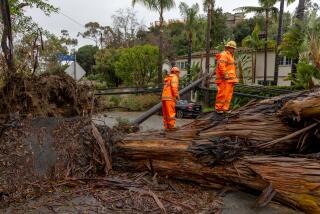More than 1 million Californians could lose power Sunday amid the windiest, driest conditions of the year
Pacific Gas and Electric may cut power to more than 1 million people in Northern and Central California on Sunday amid extreme fire weather that’s expected to bring the strongest winds and driest conditions of the year.
The utility undertakes the preemptive blackouts, which it calls public safety power shutoffs, to avoid a situation in which wind gusts could snap off tree branches or damage a piece of equipment, creating a spark that could ignite dry brush and lead to the next wildfire disaster.
Powerful and dry Diablo winds are forecast to sweep through the area starting Sunday, with sustained speeds of 25-35 mph and gusts of up to 70 mph in higher elevation areas, according to the National Weather Service.
“Initial forecasts indicate this could be our largest PSPS event this year so far,” Michael Lewis, PG&E’s interim president, said in a statement. “Our highest priority is to keep customers and communities safe and execute this event according to our plan and to then quickly restore power to all affected customers when it’s safe to do so.”
An estimated 466,093 customers in portions of 38 Northern California counties could lose power as early as Sunday morning, the utility said in a news release. That amounts to more than 1.1 million people assuming each customer represents two to three people.
Power is expected to be restored within 12 hours after the winds subside from Monday to Tuesday morning, PG&E said.
The areas where the shutoffs are most likely to move forward are the northern and western Sacramento Valley, the Northern and Central Sierra, higher elevation portions of the Bay Area, including the Santa Cruz Mountains, the Central Coast region and portions of southern Kern County, the utility said.
El Dorado County was projected to see the most customers lose power, 41,009; followed by Nevada County with 40,252; Alameda County with 39,401; Sonoma County with 38,120 and Tuolumne County with 33,271, according to PG&E.
The National Weather Service has issued red-flag warnings for the entire Bay Area, which means forecasters have high confidence that dangerous fire conditions will be in place.
“This is expected to be the strongest wind event of 2020,” said David King, meteorologist with the National Weather Service in Monterey.
Southern California is also expected to see fire weather conditions. The weather service has issued a red-flag warning for all of Los Angeles and Ventura counties, except the Antelope Valley, starting late Sunday night and lasting through Tuesday evening. A high wind warning is also in effect late Sunday through Monday afternoon.
The winds could also whip up coastal waters out to Catalina Island, causing choppy seas and wind waves into the harbor, with gale force winds possible Monday, officials said.
Southern California Edison has not announced plans for any preemptive power shutoffs in its service area.
The winds in Northern California are expected to pick up about 11 a.m. Sunday in the North Bay Mountains and East Bay hills, increasing gradually throughout the day in areas above 1,000 feet, King said. By Sunday evening, the winds are expected to intensify and become more widespread, affecting a broader swath that encompasses much of the Bay Area, including the East Bay and Santa Clara valleys, the Santa Cruz Mountains and the San Francisco Peninsula, he said.
The strongest and most widespread period of wind is expected to be Sunday night into Monday morning, with sustained speeds of up to 35 mph and gusts of up to 70 mph at higher elevations. The winds are expected to start to subside Monday morning, but conditions will remain dry and breezy in higher terrain areas until Tuesday morning, King said.
He noted that vegetation is already critically dry since the area saw no rain in February and only limited rain in the spring.
The lack of rain contributed to an early start to this year’s fire season, which has become California’s worst on record in terms of acreage burned — more than 4 million — with fires also killing 31 people and destroying more than 8,200 structures over the past three months, according to the California Department of Forestry and Fire Protection.
Previously, California’s worst year of fire was 2018, when more than 1.8 million acres burned and more than 100 people were killed, according to the National Interagency Coordination Center.
Lightning in August ignited many of California’s biggest blazes, but scientists say climate change has also contributed to the conflagrations. It was the hottest August on record in the state, and trees and brush were already abnormally combustible after much of the state saw exceptionally dry conditions last winter.
More than 5,300 firefighters continued to battle 21 fires across the state as of Saturday, according to Cal Fire, which said it had increased staffing and was pre-positioning resources in high-risk areas ahead of the anticipated winds.
Twenty-four new wildfires ignited Friday, but firefighters were able to contain all but two of them: the Pope fire east of Angwin in Napa County, which had burned 67 acres and was 70% contained, and the Redwood fire in a remote area of Humboldt County, which burned 102 acres and was 80% contained.
The Pope fire was not threatening any communities, and fire officials were confident they’d gained the upper hand, Will Powers, public information officer with Cal Fire, said Saturday.
“As for the predicted red-flag warnings that will be taking effect tomorrow in the afternoon, of course that is a concern for us in the north region, but we are prepared,” he said.
He said that firefighters have formed task forces with local government agencies “that are strategically placed throughout the north region and are ready to respond to any new starts that may occur.”
The wind event forecast to start Sunday is reminiscent of the one that fueled the Kincade fire that burned more than 77,000 acres in Sonoma County wine country last year, King said. That fire was sparked by PG&E transmission lines, which remained energized despite a public safety power shutoff that saw other PG&E equipment in the area turned off, according to a state fire department investigation.
Unlike onshore winds, which bring in moisture as they blow from the ocean over the land, Diablo winds originate inland, gaining speed, warming up and drying out as they move from higher to lower elevations and squeeze through narrow canyons and passes.
“When they switch to offshore, that’s when you have much drier winds that come over the region and further dry out fuels that are already at critically dry levels,” King said. “So with the strong winds and the dry conditions you can get a fire start.
“And if a fire starts, whether from the winds or unfortunately from people doing incorrect things, that can spread very rapidly when you have winds of the strength and magnitude that we’re expecting this Sunday night.”
This would be PG&E’s fifth preemptive blackout of the year, according to a news release. During each of the previous four, the utility’s equipment sustained damage that could have ignited fires, had the power not been cut, PG&E said.
PG&E’s equipment has already been blamed for causing some of the worst wildfires in state history, including the Camp fire, which devastated the town of Paradise in 2018, killing 85 people and destroying nearly 14,000 homes. PG&E pleaded guilty to 84 counts of involuntary manslaughter in connection with the fire.
In May, the California Public Utilities Commission approved a record $1.9-billion penalty against PG&E after investigators found the utility failed to properly maintain and operate its power lines, sparking a series of deadly fires in 2017 and 2018 that led to an estimated $30 billion in claims against PG&E. The utility agreed to pay $25.5 billion to settle those damage claims, as well as others relating to the 2015 Butte fire, as part of a bankruptcy reorganization announced in June.
Most recently, PG&E said that California investigators were looking at its equipment as a possible cause of the Zogg fire that started last month in Shasta County, killing four people and burning more than 56,000 acres in the Sierra Nevada Mountains.
Despite the history of its equipment sparking fires, PG&E came under heavy criticism for sweeping precautionary outages that left millions of Californians in the dark last October, with many residents and public officials complaining that the utility didn’t give enough notice or target the shutoffs narrowly enough. PG&E later admitted it had failed to notify 23,000 customers of the outages.
This time, PG&E began notifying affected customers via text, email and robocall Friday afternoon, the utility said. PG&E also plans to open 109 community resources centers to provide those who lose power with bathrooms, handwashing stations, Wi-Fi, the ability to charge medical equipment, water and snacks, it said.
Forecasters say the weather shift is a result of a cold low pressure system high in the atmosphere that’s moving down into the Great Basin, causing a change in air pressure that will impart strong and gusty north-northeast winds through the mountain passes up and down California.
“It’s a wide-ranging weather system over the Western United States that’s going to affect a lot of areas in different ways,” said Joe Sirard, meteorologist with the National Weather Service in Oxnard.
The same weather system is expected to bring freezing temperatures and snow to Colorado and northern Utah, as well as powerful Santa Ana winds to Southern California, he said.
“This is the first strong Santa Ana event of the year,” Sirard said. “It’s going to be widespread and it’s going to be strong. We could have tree limbs down and some scattered power outages will not be out of the question, in addition to the extreme fire danger.”
The Santa Ana winds are expected to start blowing overnight Sunday into Monday, after midnight, and persist through Monday afternoon, with damaging gusts of up to 65 mph in lower elevations and up to 75 mph in mountain areas, Sirard said.
Like the Diablo winds, Santa Anas blow offshore, drying out as they move over the land. The winds are expected to cause humidities to plummet into the teens and single digits Monday morning into the afternoon, Sirard said.
More to Read
Start your day right
Sign up for Essential California for news, features and recommendations from the L.A. Times and beyond in your inbox six days a week.
You may occasionally receive promotional content from the Los Angeles Times.







